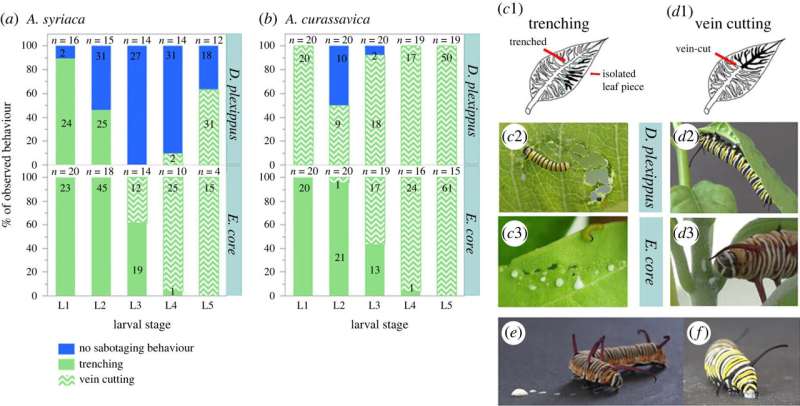March 11, 2024 report
This article has been reviewed according to Science X's editorial process and policies. Editors have highlighted the following attributes while ensuring the content's credibility:
fact-checked
peer-reviewed publication
trusted source
proofread
Monarch caterpillar found to switch from avoiding milkweed-toxin-rich latex to eating it as they age

A trio of German entomologists has found that young monarch caterpillars switch from avoiding milkweed-toxin-rich latex to eating it as they get older. Their paper is published in the journal Proceedings of the Royal Society B.
Prior research has shown that monarch caterpillars have developed a way to eat milkweed leaves despite their rich load of toxin-rich latex. They bite a vein and then wait for the milky substance to drain out of the leaf, and then dig in. But there is much more to the story as the researchers in this new study learned.
Monarch butterflies lay their eggs on milkweed leaves. Three to five days later, the eggs hatch into caterpillars, which grow and molt several times before generating a chrysalis in which they metamorphose into a butterfly. For this new study, the researchers watched the caterpillars grow from the time they hatched until they formed their chrysalis and found that after the caterpillars grew to a certain size, they stopped avoiding the milky goo and began to consume it.
Surprised by the discovery, the researchers wanted to find out it if was completely intentional. They fed some of the caterpillars small doses of toxin-rich latex directly from a pipette and found that they were just as eager to consume the material. They describe it as like watching a cat lap up milk.
Prior research has shown that some of the materials in milkweed are toxins called cardenolides—when consumed by some animals, they destroy an enzyme in their gut that is responsible for balancing sodium and potassium levels—without the enzyme, the animal typically dies. But the older caterpillars, the research team found, were able to convert the cardenolides into less toxic forms. And that allowed the caterpillars to hold the toxins in their bodies, helping to fend off predators.
More information: Anja Betz et al, Late-instar monarch caterpillars sabotage milkweed to acquire toxins, not to disarm plant defence, Proceedings of the Royal Society B: Biological Sciences (2024). DOI: 10.1098/rspb.2023.2721
Journal information: Proceedings of the Royal Society B
© 2024 Science X Network
















